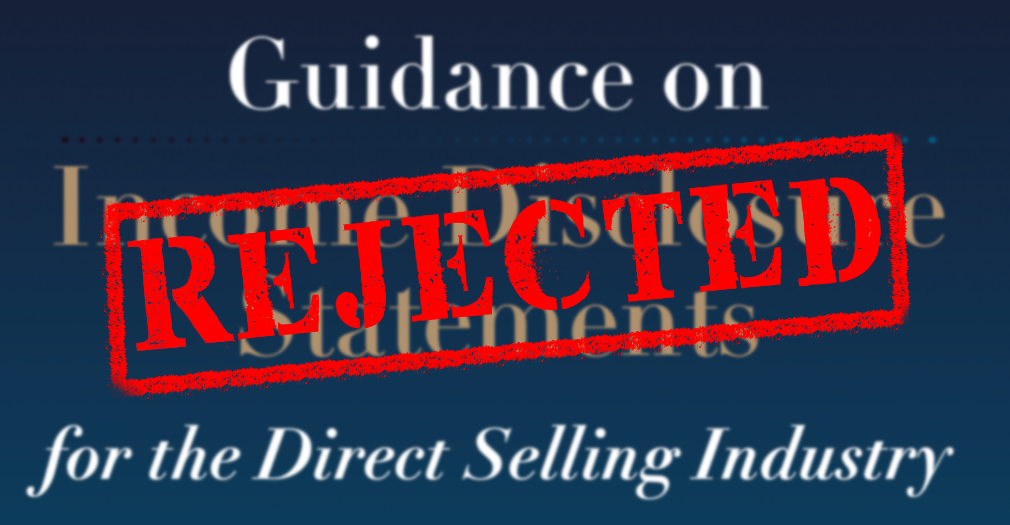
TINA.org Joins Consumer Advocates to Keep FTC Bipartisan
Why agency independence is in the best interests of consumers.
Despite the availability of the data, MLM earnings statements fail to disclose crucial information to recruits, writes guest blogger William Keep.
| William Keep, Ph.D.
What are the odds of achieving life-changing wealth as a multi-level marketing (Multilevel Marketing – a way of distributing products or services in which the distributors earn income from their own retail sales and from retail sales made by their direct and indirect recruits.) distributor? Or, how about earning enough to quit a current full-time job? Or, at the very least, what is the probability of earning more than the equivalent of working a few hours a week at minimum wage? One of the most curious aspects of how MLM companies communicate to recruits is their refusal to disclose available data that would meaningfully inform the decision to participate.
MLM companies typically tout two income opportunities: 1) income from selling products to non-distributor customers [and sometimes to other distributors] at a mark-up above distributors’ cost and 2) income from products sold by the MLM company to recruits in a distributor’s downline. There is no verifiable information on income from mark-up on distributors’ retail sales at either the firm or industry level. It would seem that distributors and recruits would be more motivated if they had reliable evidence of this source of income. Curiously, as seen by their lack of disclosure, MLM companies do not see it that way.
That leaves income paid out by the MLM company based on purchases made by a distributor and her/his downline. As the payer, the MLM company knows who gets paid, how much, and when. Particularly important to determining the probability of success, the MLM company knows who continues to earn rewards from one year to the next and at what levels in the pay scale. Let’s call that “persistence.” Despite readily available data, the disclosed public earnings statements from MLM companies have little validity and obscure rather than share this pertinent information. Why?
MLM Earnings Statements: The Art of Confusion
A sample of earnings statements shows critical flaws that make the information not just worthless but dangerous, as hidden (i.e., undisclosed) odds can mislead distributors and prospective recruits. The flaws fall into three categories: 1) the meaning of the data as presented, 2) the unverifiable company narrative about the data and, most importantly, 3) the unreported persistence of top earners.
Statements produced by Jeunesse and Advocare demonstrate how what could be otherwise clear data can instead be made obscure and difficult to understand. Jeunesse’s totally incoherent initial statement on 2014 earnings—a mishmash of averages that contradicted each other—prompted TINA.org to raise sufficient concerns to cause the company to retract the document. Given the lack of regulatory oversight, it takes little imagination to wonder what would have happened in the absence of TINA.org’s vigilance.
Similarly, Advocare generated a 2014 earnings statement with annualized averages (not actual annual income), monthly income by pay level but without indicating the number of months of earnings and, at the bottom, actual income earned by income category but not according to pay level. As it turns out, 70% of Advocare distributors had no earnings from the company and, of the 30% who did, 84.7% earned between $1 and $1,000 (no word on how many were at the lower end; e.g., near zero). In sum, 95.4% of all Advocare distributors earned between $0 and $1,000 for the year. At Jeunesse, the percent earning $0 to $1,000 is 96.3%.
Advocare’s reported average annualized earnings per level adds real confusion, giving the impression that total potential company payout could reach over $800 million when the amount actually paid out to distributors, according to the 2014 earnings statement, was $249,258,590 (i.e., 31% of the implied annualized potential). Applying that percentage to the average annualized earnings of the three largest categories suggests that 97.3% of Advocare distributors likely earned on average around $691 in 2014. That amount is less than income earned from working two hours per week at minimum wage—let alone the fact that disclosed income refers to gross income, not net earnings after business expenses.
Nu Skin took a similar approach, reporting $2,066.46 as the average annual amount paid to Active Distributors and then adding that, IF the average monthly payout were annualized, the total for the year would be $13,273.30. This latter amount, i.e., 6.4 times actual annual distributor earnings, clearly lacks substantiation. Many Nu Skin Active Distributors do not sustain gross earnings month-to-month as only 15.57% earn a payout in any given month. In a document that purports to disclose distributor earnings, why report a “potential” that has never been realized and for which the company has no reasonable basis to think it ever could be?
Explaining Distributor Motivations After the Fact
After complaints from TINA.org, Jeunesse generated a new earnings statement similar in format to those published by Nu Skin and Herbalife. Basically, the statements list earnings by income category and the number of distributors in each. However, unverifiable company narratives may rightfully confuse potential recruits. Jeunesse claims that it “provides the numbers and percentages of those who simply wish to purchase and use products” but then describes the 72.25% of Distributors who earn $0 as a category that “includes those who purchase for personal consumption.” OK. So where are the “numbers and percentages of those who simply wish to purchase and use products”?
Herbalife-sponsored research claims, “A substantial majority (73%) join us primarily to receive a discounted price on products they and their families enjoy,” while an industry study reported distributors were as equally motivated by the prospect of earning “long-term supplemental income” as getting “products as a discount.” If both claims are true, where is the growing customer base of members who are no longer distributors? Why do we not see sales by the MLM industry growing as a percent of total retail sales?
Persistence and the Hidden Probability of Failing
A further dangerous flaw in earnings statements is the absence of any information regarding the persistence of top earners. For 2014, Nu Skin reported that .53% (.0053) of Active Distributors, approximately 1 in 190, may earn $50,000 or above. Since Active Distributors are 38.25% of all Distributors, the odds of any one Distributor earning $50,000 or more appear to be about 1 in 500.
But with no information on the persistence of top earners literally any calculation of a participant’s probability of success is useless. If all were to persist and the number of top distributors remain essentially unchanged, then the probability of success for any Distributor not already earning $50,000 or above goes to zero. Critically, the probability of desired success hinges on the number of net new top earners each year — information readily available to the company but unreported. That Nu Skin agreed in 1994 to “settle allegations that they falsely represented the earnings potential of Nu Skin distributors” raises serious questions about why the Federal Trade Commission (FTC) has not paid more attention to MLM earning statements as a source of deceptive advertising.
A similar analysis of Herbalife demonstrates that the odds of earning $50,000 or more appear to be roughly the same as for Nu Skin but could be 3 in 10,000 or even less depending on the persistence of top earners. Herbalife further obscures information that could be clear when reporting the ascendance to the President’s Team.
In short, despite the availability of the data, MLM earnings statements fail to provide the information needed for a prospective distributor to assess the probability of a successful business venture. The next time the Direct Selling Association (DSA) talks about high ethical standards in the MLM industry or the FTC claims more information will not provide greater consumer protection, just smile and hand them a copy of this article.
The views, opinions, and positions expressed in this blog post do not necessarily reflect the views, opinions, and positions of TINA.org.
Why agency independence is in the best interests of consumers.
Advisory opinion letter raises “serious concerns” with self-reg group’s guidance.
Why the MLM industry should avoid the term.


